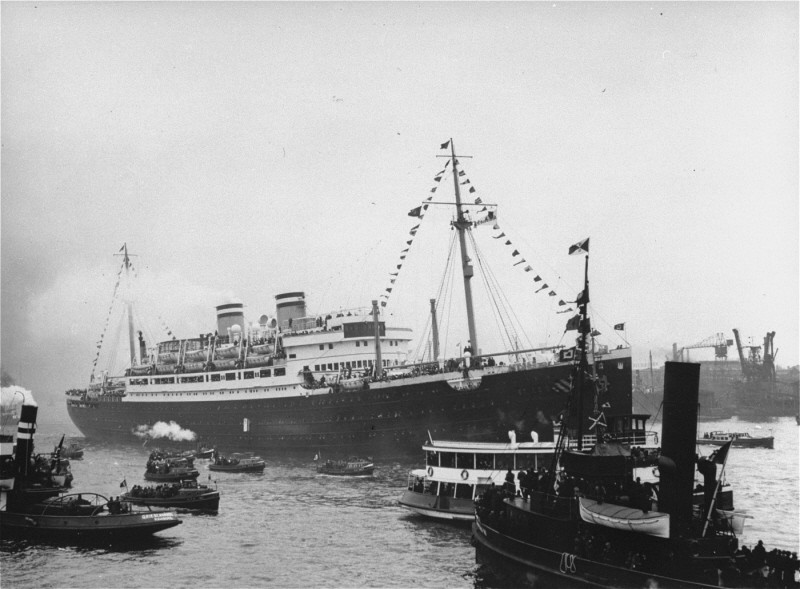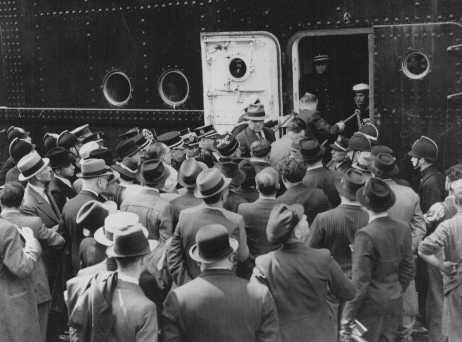
Voyage of the St. Louis
In May 1939, the German liner St. Louis sailed from Hamburg, Germany, to Havana, Cuba. The 937 passengers were almost all Jewish refugees. Cuba's government refused to allow the ship to land. The United States and Canada were unwilling to admit the passengers. The St. Louis passengers were finally permitted to land in western European countries rather than return to Nazi Germany. Ultimately, 254 St. Louis passengers were killed in the Holocaust.
Key Facts
-
1
After the St. Louis arrived in Havana, the passengers learned that the Cuban government had canceled their landing permits. The American Jewish Joint Distribution Committee (JDC) negotiated with Cuba on behalf of the passengers, but the negotiations failed and the Cuban government forced the ship to leave the harbor.
-
2
Although the ship sailed near the Florida coast, the US government did not allow the passengers to land, since they did not have US immigration visas and had not passed a security screening. American newspapers publicized the saga and many Americans sympathized with the passengers.
-
3
Great Britain, France, Belgium, and the Netherlands each admitted a percentage of the passengers upon their return to Europe in June 1939. Many passengers were able to obtain immigration visas and leave for the United States before the German invasion of western Europe in May 1940, but 254 passengers were killed in the Holocaust.

On May 13, 1939, the German transatlantic liner St. Louis sailed from Hamburg, Germany, for Havana, Cuba. On the voyage were 937 passengers. Almost all were Jews fleeing from the Third Reich. Most were German citizens, some were from eastern Europe, and a few were officially "stateless."The majority of the Jewish passengers had applied for US visas, and had planned to stay in Cuba only until they could enter the United States.
But by the time the St. Louis sailed, there were signs that political conditions in Cuba might keep the passengers from landing there. The US State Department in Washington, the US consulate in Havana, some Jewish organizations, and refugee agencies were all aware of the situation. The passengers themselves were not informed; most were ultimately compelled to return to Europe.
Before the Voyage
Since Kristallnacht (often referred to in English as the "Night of Broken Glass") on November 9–10, 1938, the German government had sought to accelerate the pace of forced Jewish emigration. The German Foreign Office and the Propaganda Ministry also hoped to exploit the unwillingness of other nations to admit large numbers of Jewish refugees to justify the Nazi regime's anti-Jewish goals and policies both domestically in Germany and in the world at large.
The owners of the St. Louis, the Hamburg-Amerika Line, knew even before the ship sailed that its passengers might have trouble disembarking in Cuba. The passengers, who held landing certificates and transit visas issued by the Cuban Director-General of Immigration, did not know that Cuban President Federico Laredo Bru had issued a decree just a week before the ship sailed that invalidated all recently issued landing certificates. Entry to Cuba required written authorization from the Cuban Secretaries of State and Labor and the posting of a $500 bond (The bond was waived for US tourists).
Hostility toward Immigrants in Cuba

The voyage of the St. Louis attracted a great deal of media attention. Even before the ship sailed from Hamburg, right-wing Cuban newspapers deplored its impending arrival and demanded that the Cuban government cease admitting Jewish refugees. Indeed, the passengers became victims of bitter infighting within the Cuban government. The Director-General of the Cuban immigration office, Manuel Benitez Gonzalez, had come under a great deal of public scrutiny for the illegal sale of landing certificates. He routinely sold such documents for $150 or more and, according to US estimates, had amassed a personal fortune of $500,000 to $1,000,000. Though he was a protégé of Cuban army chief of staff (and future president) Fulgencio Batista, Benitez's self-enrichment through corruption had fueled sufficient resentment in the Cuban government to bring about his resignation.
More than money, corruption, and internal power struggles were at work in Cuba. Like the United States and the Americas in general, Cuba struggled with the Great Depression. Many Cubans resented the relatively large number of refugees (including 2,500 Jews), whom the government had already admitted into the country, because they appeared to be competitors for scarce jobs.
Hostility toward immigrants fueled both antisemitism and xenophobia. Both agents of Nazi Germany and local right-wing movements hyped the immigrant issue in their publications and demonstrations, claiming that incoming Jews were Communists. Two of the papers—Diario de la Marina, owned by the influential Rivero family, and Avance, owned by the Zayas family, had supported the Spanish fascist leader General Francisco Franco, who, after a three-year civil war, had just overthrown the Spanish Republic in the spring of 1939 with the help of Nazi Germany and Fascist Italy.
Reports about the impending voyage fueled a large antisemitic demonstration in Havana on May 8, five days before the St. Louis sailed from Hamburg. The rally, the largest antisemitic demonstration in Cuban history, had been sponsored by Grau San Martin, a former Cuban president. Grau spokesman Primitivo Rodriguez urged Cubans to "fight the Jews until the last one is driven out." The demonstration drew 40,000 spectators. Thousands more listened on the radio.
Arrival of the St. Louis in Havana

When the St. Louis arrived in Havana harbor on May 27, the Cuban government admitted 28 passengers: 22 of them were Jewish and had valid US visas; the remaining six—four Spanish citizens and two Cuban nationals—had valid entry documents. One further passenger, after attempting to commit suicide, was evacuated to a hospital in Havana. The remaining 908 passengers (one passenger had died of natural causes en route)—including one non-refugee, a Hungarian Jewish businessman—had been awaiting entry visas and carried only Cuban transit visas issued by Gonzalez. 743 had been waiting to receive US visas. The Cuban government refused to admit them or to allow them to disembark from the ship.
After Cuba denied entry to the passengers on the St. Louis, the press throughout Europe and the Americas, including the United States, brought the story to millions of readers throughout the world. Though US newspapers generally portrayed the plight of the passengers with great sympathy, only a few journalists and editors suggested that the refugees be admitted into the United States.
On May 28, the day after the St. Louis docked in Havana, Lawrence Berenson, an attorney representing the US-based Jewish Joint Distribution Committee (JDC), arrived in Cuba to negotiate on behalf of the St. Louis passengers. A former president of the Cuban-American Chamber of Commerce, Berenson had had extensive business experience in Cuba. He met with President Bru, but failed to persuade him to admit the passengers into Cuba. On June 2, Bru ordered the ship out of Cuban waters. Nevertheless, the negotiations continued, as the St. Louis sailed slowly toward Miami. Bru offered to admit the passengers if the JDC posted a $453,500 bond ($500 per passenger). Berenson made a counteroffer, but Bru rejected the proposal and broke off negotiations.
You know, we always cling to the hope something is going to happen. They're not going to let us rot on the ocean. I mean, something had to happen to us. Of course, the fear was that we would go back to Germany.
Seeking Refuge
Sailing so close to Florida that they could see the lights of Miami, some passengers on the St. Louis cabled President Franklin D. Roosevelt asking for refuge. Roosevelt never responded. The State Department and the White House had decided not to take extraordinary measures to permit the refugees to enter the United States. A State Department telegram sent to a passenger stated that the passengers must "await their turns on the waiting list and qualify for and obtain immigration visas before they may be admissible into the United States." US diplomats in Havana intervened once more with the Cuban government to admit the passengers on a "humanitarian" basis, but without success.
Obstacles to Immigration to the United States
Quotas established in the Immigration Act of 1924 (the Johnson-Reed Act) strictly limited the number of immigrants who could be admitted to the United States each year. In 1939, the annual combined German-Austrian immigration quota was 27,370 and was quickly filled. In fact, there was a waiting list of at least several years. US officials could only have granted visas to the St. Louis passengers by denying them to the thousands of German Jews placed further up on the waiting list. Public opinion in the United States, although ostensibly sympathetic to the plight of refugees and critical of Hitler's policies, continued to favor immigration restrictions.
The Great Depression had left millions of people in the United States unemployed and fearful of competition for the scarce few jobs available. It also fueled antisemitism, xenophobia, nativism, and isolationism. A Fortune Magazine poll at the time indicated that 83 percent of Americans opposed relaxing restrictions on immigration. President Roosevelt could have issued an executive order to admit the St. Louis refugees. However, public hostility towards immigrants and other political considerations made him reluctant to take this step. Isolationist Republicans, for example, had gained seats in the Congressional elections of 1938. Furthermore, Roosevelt was considering running for an unprecedented third term as president.
Three months before the St. Louis sailed, Senator Robert Wagner (D-N.Y.) and Representative Edith Rogers (R-Mass.) introduced legislation that would have admitted 20,000 German refugee children outside of the existing quota. After months of debate, Congressional leaders allowed the Wagner-Rogers Bill to die before it could come to a vote.
Two smaller ships carrying Jewish refugees sailed to Cuba in May 1939. The French ship, the Flandre, carried 104 passengers; the Orduña, a British vessel, held 72 passengers. Like the St. Louis, these ships were not permitted to dock in Cuba. The Flandre turned back to its point of departure in France, while the Orduña proceeded to a series of Latin American ports. Its passengers finally disembarked in the US-controlled Canal Zone in Panama. The United States eventually admitted most of them.
Return to Europe
Following the US government's refusal to permit the passengers to disembark, the St. Louis sailed back to Europe on June 6, 1939. The passengers did not return to Germany, however. Jewish organizations (particularly the Jewish Joint Distribution Committee) negotiated with four European governments to secure entry visas for the passengers:
- Great Britain took 288 passengers
- the Netherlands admitted 181 passengers
- Belgium took in 214 passengers
- 224 passengers found at least temporary refuge in France.

Of the 288 passengers admitted by Great Britain, all survived World War II save one, who was killed during an air raid in 1940. Of the 620 passengers who returned to the continent, 87 (14%) managed to emigrate before the German invasion of western Europe in May 1940. The 532 St. Louis passengers who were unable to emigrate in time became trapped when Germany conquered western Europe. Just over half of them—278 people—survived the Holocaust. The 254 passengers who died included 84 who had been in Belgium; 84 who had found refuge in Holland; and 86 who had been admitted to France.
Critical Thinking Questions
What pressures and motivations may have affected decisions made by Cuban and US government officials about the St. Louis?
Investigate the arrival of other refugee ships in Havana in 1939. Was the St. Louis experience typical for arrivals, or was it an exception?
What responsibilities do (or should) other nations have regarding refugees from oppressive regimes?

